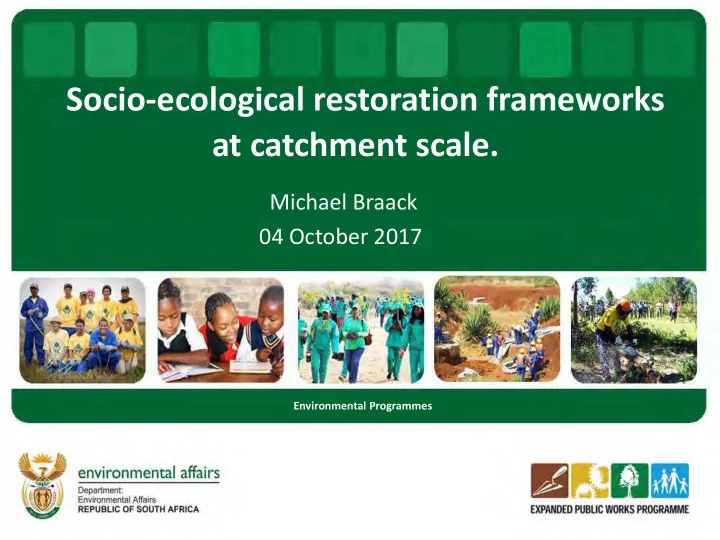

Socio-ecological restoration frameworks at catchment scale. Michael Braack 04 October 2017 Environmental Programmes
Upper Umzimvubu Storage Space (m3) 500 000 Catchment size (ha) 77 100 % Silted Up after 4 year 70% Volume Silted Up after 4 year 350 000 Years after completion 4 Siltation/Year 87 500 Soil Loss per Hectare per Year (m3/ha/year) 1.13 % of Catchment Degraded 30% Area Degraded 23 130 Soil Loss per Degraded Hectare per Year (m3/ha/year) 3.78
Data source: NLC 2000
Ntabalenga Landcover – T35 catchment Description Hectares % Barren rock 2774 0.56% Cultivated: permanent - commercial dryland 153 0.03% Cultivated: temporary - commercial dryland 14878 3.02% Cultivated: temporary - subsistence dryland 59795 12.14% Degraded: unimproved grassland 92239 18.72% Dongas & sheet erosion scars 356 0.07% Forest 829 0.17% Forest and Woodland 8 0.00% Plantations 19819 4.02% Improved grassland 20 0.00% Shrubland and low Fynbos 105 0.02% Thicket & bushland (etc) 12433 2.52% Unimproved grassland 274453 55.70% Urban / built-up land: residential 12219 2.48% Waterbodies 387 0.08% Wetlands 2240 0.45% 492708 100% Data source: NLC Total degraded Catchment Areas – 74.49% 2000
Land Degradation Processes Unsustainable farming practices Increased soil surface sealing Soil Erosion Increased run off Injudicious use of Fire Increased water velocities Decrease vegetation cover Increased connectivity Decline in soil fertility Increased IAP invasions . Reduced grazing capacity
Habitat Loss Hydrological modification Change in groundwater level/ quality
Land Degradation direct impact on peoples livelihoods.
Gully erosion – up to 17 Old lands – between 70 to tons per ha 120 t/h/pa Sheet erosion - up to 23 2015 Status – 10 500 000 (m 3 ) pa t/ha/pa 20t C per degraded Has 92 239 has 6 770 343 t CO2e 225 678.09 t CO2e Per year R 22 567 809 PES per year @R100 per ton
NLEIP Vision • “To support sustainable livelihoods for local people through integrated landscape management that strives for resilient social- ecological systems and which fosters equity in access to ecosystem services .” • Land restoration follows a holistic approach, combines grazing, fire and storm water management to improve vegetation cover, slow excessive water movement down and support land- based livelihood options that are sustainab
Stakeholder Engagement • Central to this aim is the need to fully involve the resident users of the natural resources in all stages of planning and implementation. • Relevant systems, support and capacity needs to be developed to ensure resource users become the effective managers of the resources .
Implementation SES Engagement Monitoring Social Engagement, Planning and Implementation Simplistic Planning and Implementation Land Management Improved Ecosystem Improved Human Well SES Engagement Interventions Services Being Decreased exposure to Engagement understanding natural disasters (fire, uses. Clear Invasive Alien plants. Increased Water Yield floods etc.) Flood Risk Reduction Improved food security Why is it degraded and what Improved water quality is the land being used for Restore degraded land to through filtering of reduce soil erosion pollutants and toxins Improved health Restore degraded landscapes - bush and tree thickening Improved soil water What has changed and why? management. retention Improved fisheries Why is degraded and what is Increased base flow in Safe and plentiful drinking Rehabilitate Wetlands dry seasons. water driving the degradation? Fire management - fuel load Understanding existing fire reduction and burning fire regimes and causes. belts Fire Risk Reduction Reduced Sediment load in rivers Existing land use planning Manage buffers of vegetation Improved livelihood and measures along streams and rivers Improved biodiversity security Improved carbon balance Reinstate buffers of natural Existing land use planning vegetation between crops and Improved livelihood Adaptation to climate and measures rivers security change
SER – International Standards. Conceptual model of ecosystem degradation and responses to it through restoration (Adapted from Keenleyside et al. 2012 and Whisenant 1999; cf. Hobbs & Harris 2001).
United Nations Convention to Combat Desertification LDN - The key elements of the scientific conceptual framework for LDN and their interrelationships.
Conceptualizing LDN in a cause and effect model within the socio-ecological system. Solid arrows indicate cause-effect relationships; dotted arrows indicate response relationships.
The NLEIP central conceptual framework (Fabricius et al. 2016).
SER restorati on wheel
Restorative continuum. Ecological restoration and restorative management can be seen to be aligned along a ‘restorative continuum’ where a broad range of activities undertaken by society to repair damage to the broader environment, complement ecological restoration and provide improved conditions for broad scale recovery.
Monitoring – Acting local, linking poverty alleviation to Scientific monitoring Jam-jars, poles and chlorine pills Jam-jars, smartphones, and Open Data Kit, Michael Powell 2016
Hydrograph 26 October – 8 November 2016 illustrating real time capture of downstream sediment routing
Landscape Connectivity
Ntabelanga catchment with 2km buffer around villages
Restoration technologies grown in the catchment by the community.
Mbraack@environment.gov.za Thank You
Recommend
More recommend